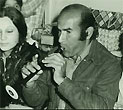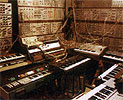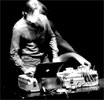 Here at Rummage we love cheesy analog electronica and musical scenes with silly names, so we feel a natural affinity for skweee - a form of cheap and cheerful 8-bit-level instrumental electro that's apparently all the rage in Scandanavia. The pre-eminent purveyor of this new species of bleep is Swedish label, Flogsta Danshall, who have just released a new compilation of it called Museum of Future Sound 2. Here's a track from said compilation:
Here at Rummage we love cheesy analog electronica and musical scenes with silly names, so we feel a natural affinity for skweee - a form of cheap and cheerful 8-bit-level instrumental electro that's apparently all the rage in Scandanavia. The pre-eminent purveyor of this new species of bleep is Swedish label, Flogsta Danshall, who have just released a new compilation of it called Museum of Future Sound 2. Here's a track from said compilation:
The album can be purchased as mp3s from the label, and MySpace pages of the various artists in the scene can be found here.
 I don't know about the rest of you, but my school music class experiences were decidedly uninspiring... We either spent our half hour a week listening to Andrew Lloyd Webber musicals (an activity that only became interesting when we got to hear the "rude words" in Dangerous Jade) or tooling around with those butt-ends of the percussion section - the triangle and the castanets.
I don't know about the rest of you, but my school music class experiences were decidedly uninspiring... We either spent our half hour a week listening to Andrew Lloyd Webber musicals (an activity that only became interesting when we got to hear the "rude words" in Dangerous Jade) or tooling around with those butt-ends of the percussion section - the triangle and the castanets.
Nothing so banal though for the kids who attended Gloucester Public School in the 70's. Those little brats had access to their own electronic music lab. And they were given carte blanche to churn out any squealing random noise they liked!
Spoilt buggers... Here's Randy Kaplan with something I wish I could've done in a music class at age twelve.
Randy Kaplan - Emission Embossment
This track comes from a CD put together by Jack Dangers from Meat Beat Manifesto, which was featured on the WFMU blog
 These days, it's fairly common for a big name artist to release downloadable versions of a handful of tracks on their website. How often though do you see a whole (or most thereof) back catalogue? Shortly before Christmas, oddball electronica maestro Kristin Erickson (aka Kevin Blechdom) put up her entire solo output, two Blectum From Blechdom CDs, and a host of early works from the Erickson family band, Adult Rodeo. And it's all free! (Top that, Radiohead!)
These days, it's fairly common for a big name artist to release downloadable versions of a handful of tracks on their website. How often though do you see a whole (or most thereof) back catalogue? Shortly before Christmas, oddball electronica maestro Kristin Erickson (aka Kevin Blechdom) put up her entire solo output, two Blectum From Blechdom CDs, and a host of early works from the Erickson family band, Adult Rodeo. And it's all free! (Top that, Radiohead!)
If you're yet to be exposed to Kevy B's oeuvre, prepare to enter a magical world of icky sex, cheesy romance, bad hygiene and pornographic animal experimentation. Here, as a taster, are two tracks off her 2005 album, Bitches Without Britches. The first is a banjo-driven foot-stomper with some of her most luridly off-colour lyrics; the second contains possibly the only reference to Kid 606's penis in all popular music.
Kevin Blechdom - Binaca
Kevin Blechdom - Mister Miguel
(And the best of this is yet to come... In the very near future, Kev will hopefully be posting pdfs of the seriously depraved cartoon inserts that accompany her releases.)
 Zadik Zecharia, who hails from Kurdistan but has lived in Israel since 1950, is a master of the zorna, a reed instrument which sounds like a shriller version of the bagpipes, and which Zecharia wields like a diamond-tipped drill to the skull. Here’s an mp3 of him performing a style of Kurdish dance music called chopie.
Zadik Zecharia, who hails from Kurdistan but has lived in Israel since 1950, is a master of the zorna, a reed instrument which sounds like a shriller version of the bagpipes, and which Zecharia wields like a diamond-tipped drill to the skull. Here’s an mp3 of him performing a style of Kurdish dance music called chopie.
Last year, he was exposed to the world via a reissue of a 1980 recording of his music that was released on the Israeli label, Something On The Road. At the end of the record, SOTR tacked on two effects-drenched abstract remixes by local DJs, Gal Tushia and Davis Ovadia, which actually held up rather well in their own right. Perhaps inspired by this, SOTR have now released a whole album of remixes of Zecharia’s work by Israeli artists. As you might expect, some of them merely use the source material as a sampled adjunct to their current favourite beat, bass ‘n’ synth patterns. Others though, engage more directly with it and some interesting pieces result. Here’s a few of them:
Nemoi – basically just a simple repeated guitar phrase with Zecharia’s zorna overlayed as a melody. The whole, though, gels together beautifully and reminds me of Juana Molina sans vocals.
Yayehe Smon – in a moment of true inspiration, this artist contextualizes Zecharia by subtly incorporating the music into a field recording of a Middle Eastern street scene.
David Ovadia – goes in the complete opposite direction to Smon and turns Zecharia’s music into an echo chamber soundscape.
All of these remixes can be purchased as a CD from Aquarius Records, or they can be downloaded under a Creative Commons license from Miklataklim.
 Ever wondered what the whole history of Christmas music would sound like if it were statistically analysed and distilled into a single album?... Well, wonder no longer!
Ever wondered what the whole history of Christmas music would sound like if it were statistically analysed and distilled into a single album?... Well, wonder no longer!
Eigenradio – an internet radio project from the MIT Media Lab which regularly does this analysis on a broad cross-section of stations and extracts “only the most important frequencies, only the beats with the highest entropy” – has applied its esoteric craft to seasonal fare and come up with sixteen statistically optimal holiday standards. In this collection, all the inessential frippery of sleighbells and par-rup-pa-pums has been stripped away; leaving only a dark crystalline heart of ululating tone-scapes, discordant carnival music, and occasional insectoid scuttlings… Play it at the annual family gathering and confirm all their worst fears about you…
 Meet the Borg of synths – a fully integrated and patchable room sized assemblage of over a hundred individual synth modules, along with a variety of fully assimilated Casiotone and Moog keyboards. (Full list of modules here.) This beast is the result of 20 years worth of bower birding by Dr Joseph Paradiso. As a result of its complexity, he is able to wire up a single set of patches that will burble away indefinitely, producing sophisticated endlessly varying pieces of music (which do sound surprisingly composed), without any additional human input. A selection of mp3s of these wonderfully old-style analogue concoctions is available on his website. (via Music Thing)
Meet the Borg of synths – a fully integrated and patchable room sized assemblage of over a hundred individual synth modules, along with a variety of fully assimilated Casiotone and Moog keyboards. (Full list of modules here.) This beast is the result of 20 years worth of bower birding by Dr Joseph Paradiso. As a result of its complexity, he is able to wire up a single set of patches that will burble away indefinitely, producing sophisticated endlessly varying pieces of music (which do sound surprisingly composed), without any additional human input. A selection of mp3s of these wonderfully old-style analogue concoctions is available on his website. (via Music Thing)
(When he isn’t tending to his modular monster, Dr Paradiso works at the MIT Media Lab, where he designs esoteric musical interfaces. His most recent work of note is a pair of shoes with motion and pressure sensors that can be used as music controllers.)
 As part of an information studies course he did at UCLA in 2001, Ryan Hildebrand put together this treasure trove of mp3s by artists who have used musical technology in the "wrong" way. (Or, more correctly, have rejected the proper, time-established ways of using their tools of choice.) The collection is divided into four broadly-defined genres - glitch electronica, free improvisation and extended technique, tape music and musique concrete, and turntablism - and features close to 200 tracks by musicians/composers like John Cage, Pierre Henry, Iannis Xenakis, Karlheinz Stockhausen, Edgar Varese, Steve Reich, The Beatles, Derek Bailey, Fred Frith, AMM, John Zorn, Evan Parker, Autechre, Oval, Fennesz, Kid 606, DAT Politics, Grandmaster Flash, Christian Marclay, Kid Koala, Invizibl Skratch Piklz, and LL Cool J... just to name a few. Dive in and explore. (via Daily Jive Weblog)
As part of an information studies course he did at UCLA in 2001, Ryan Hildebrand put together this treasure trove of mp3s by artists who have used musical technology in the "wrong" way. (Or, more correctly, have rejected the proper, time-established ways of using their tools of choice.) The collection is divided into four broadly-defined genres - glitch electronica, free improvisation and extended technique, tape music and musique concrete, and turntablism - and features close to 200 tracks by musicians/composers like John Cage, Pierre Henry, Iannis Xenakis, Karlheinz Stockhausen, Edgar Varese, Steve Reich, The Beatles, Derek Bailey, Fred Frith, AMM, John Zorn, Evan Parker, Autechre, Oval, Fennesz, Kid 606, DAT Politics, Grandmaster Flash, Christian Marclay, Kid Koala, Invizibl Skratch Piklz, and LL Cool J... just to name a few. Dive in and explore. (via Daily Jive Weblog)
 Late Friday afternoon... Time to disengage the mind from work... And this week, the sonic means to that end is Sine Fiction, an netlabel/art project devoted to soundtracks inspired by notable science fiction novels. The project's been going since 2000 and has so far released 14 compositions (with another 19 in the pipeline.) The authors who've received the Sine Fiction treatment include Stanislaw Lem, Arthur C Clarke, Isaac Asimov, Philip K. Dick, Samuel Delaney, Italo Calvino, George Orwell and William S Burroughs. (In the future, we're promised H G Wells, J G Ballard, William Gibson, Margaret Atwood, and Robert Anton Wilson - just to name a few.)
Late Friday afternoon... Time to disengage the mind from work... And this week, the sonic means to that end is Sine Fiction, an netlabel/art project devoted to soundtracks inspired by notable science fiction novels. The project's been going since 2000 and has so far released 14 compositions (with another 19 in the pipeline.) The authors who've received the Sine Fiction treatment include Stanislaw Lem, Arthur C Clarke, Isaac Asimov, Philip K. Dick, Samuel Delaney, Italo Calvino, George Orwell and William S Burroughs. (In the future, we're promised H G Wells, J G Ballard, William Gibson, Margaret Atwood, and Robert Anton Wilson - just to name a few.)
The music itself its mostly boffin electronica - soundscapes, dubby glitch, moody IDM, ear-searing digi-noise, and even some musique concrete. But if any of that appeals to you, I highly recommend heading over to the site and having a good aural wallow! (via Metafilter)
 For much of the late 60’s, Hans Edler had been the teen idol front man of chart-topping Swedish band, The Ghostriders. (As the name suggests, they were heavily influenced by The Shadows.) In 1969, however, a newspaper article about the Electronic Music Studio, a state-of-the-art studio in Stockholm equipped with room-sized computers built to make music, attracted his attention. He immediately enrolled in some courses there and, in the space of two years, had recorded Elektron Kukeso, one of the first computer programmed records in history… And what a strange record it was… If a Nordic baritone-voiced Brian Wilson decided to compose electronic hymns for a rock opera about a Robot Church it might sound something like this… Needless to say, it was a commercial flop and Edler abandoned his electronic dabblings to focus on a far more stable career recording children’s records.
For much of the late 60’s, Hans Edler had been the teen idol front man of chart-topping Swedish band, The Ghostriders. (As the name suggests, they were heavily influenced by The Shadows.) In 1969, however, a newspaper article about the Electronic Music Studio, a state-of-the-art studio in Stockholm equipped with room-sized computers built to make music, attracted his attention. He immediately enrolled in some courses there and, in the space of two years, had recorded Elektron Kukeso, one of the first computer programmed records in history… And what a strange record it was… If a Nordic baritone-voiced Brian Wilson decided to compose electronic hymns for a rock opera about a Robot Church it might sound something like this… Needless to say, it was a commercial flop and Edler abandoned his electronic dabblings to focus on a far more stable career recording children’s records.
Now, some 33 1/3 years later, this album has been reissued by Boy Wonder Records. (Hopefully, the recording-buying public finds it a little more digestible this time round...) The record can be purchased through Aquarius Records and here, to whet your appetite, is the opening track, Jag soker efter karlek.
 As a sort of follow-on from the recent posting about Muppet-themed metal band Cookie Mongoloid, he’s a piece of creepy experimental work from the early career of Muppet mastermind, Jim Henson.
As a sort of follow-on from the recent posting about Muppet-themed metal band Cookie Mongoloid, he’s a piece of creepy experimental work from the early career of Muppet mastermind, Jim Henson.
In the late 60’s, Henson’s lovable puppets were already a regular fixture on the variety/talk show circuit. They hadn’t yet acquired the level of universal popularity that would come with The Muppet Show, but Muppets Inc was doing well enough to give Henson a little time off to pursue his other great interest – experimental filmmaking. One of his collaborators in these side projects was pioneer electronic composer, Raymond Scott. Together, they produced Limbo: The Organized Mind – the story of a foam-rubber-faced character who takes us inside his mind to show how things are “organized”. Very dark and unsettling… and not what you’d immediately expect from the man who did the voice for Kermit the Frog…
The soundtrack to this film (and other Henson-Scott collaborations) can be found on the wonderful collection of Scott’s 50’s – 60’s electronic works called Manhattan Research Inc, which can be purchased through Amazon.
 Back in 1997, a group of egghead wags at the Vienna-based Institute of Transacoustic Research came up with one of the more-inspired ideas in recent avant-music history... An orchestra in which every instrument is a vegetable.
Back in 1997, a group of egghead wags at the Vienna-based Institute of Transacoustic Research came up with one of the more-inspired ideas in recent avant-music history... An orchestra in which every instrument is a vegetable.
After a bit of experimentation, they came up with a whole larder full of playable produce. Some of the veges, like the gurkophone (pictured), were hollowed-out and perforated to form woodwind-type instruments; others were contact-miked then either drummed, rubbed together, or simply sliced and diced. The instruments would be assembled fresh before each Vegetable Orchestra concert then, at the end of the gig, turned into a tasty soup and served to the audience.
To date, there are two Viennese Vegetable Orchestra CDs available through their website (along with mp3s). Of these, the pick is probably their more recent effort, Automate, on which they attempt (surprisingly successfully) to replicate a variety of styles of electronic music. (There's even a Kraftwerk cover in there.) But the rawer and more diverse first CD, Gemise, is still worth getting. (If only because it has actual beans embedded in the case so you can shake along with your favourite track.)